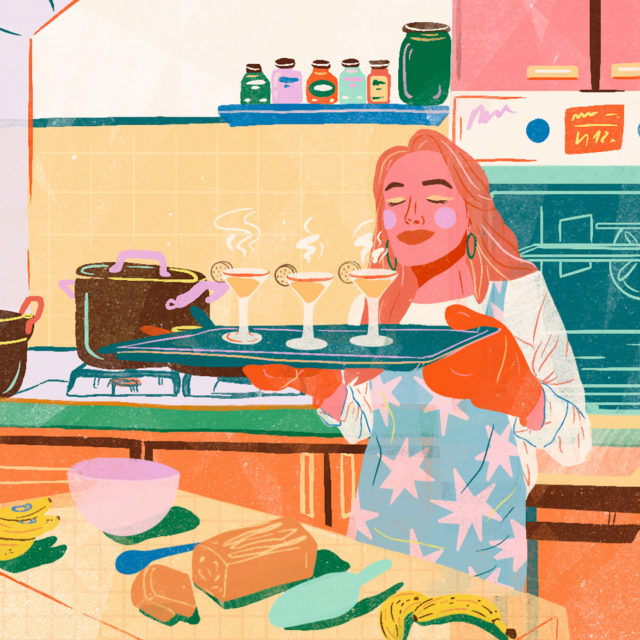The first months of the pandemic were marked by a universal craze: Baking. Turning to the comfort of carbs and hanging onto the last days of winter, people turned to their ovens — and social media — to produce and document fancy sourdoughs, cozy banana breads, and creative challahs. While the enthusiasm for baked goods has seemingly declined, stubborn bread has found a new way into our hearts: Through cocktails.
When Maria Nabi, a bartender from Brooklyn, was approached by the team at “Jimmy Kimmel Live!” to appear on the show’s new segment, Cocktail De La Casa, she has been working at Ray’s in NYC only once a week since the pandemic started, and had some time on her hands. The segment — featuring quarantined bartenders around the U.S. making delicious cocktails with ingredients viewers already have stocked in their pantries — was developed as an entertaining and uplifting way to support hospitality workers during the pandemic. Tossing ideas around, she looked to the crowds: “We asked ourselves, what are people into right now?” she says. “A lot of people were baking banana bread.” So Nabi and the Kimmel team came up with the idea to feature a banana bread cocktail. “A lot of people seemed to think it was really fun, and a few were turned off by it — maybe they had an image of me throwing banana bread in the blender,” she says. Instead, Nabi made her own banana bread, toasted it well, steeped it in whiskey overnight — extracting the flavor — then made a sour using the banana bread-infused whiskey. “The butter that’s already in the bread fat-washes the cocktail and gives it an unctuous texture,” she explains.
Fat-washing — infusing spirits with a form of grease — is a well-known technique in cocktail making. But using buttery bread baked for the occasion is definitely a quarantine inspiration. Besides, using bread as a cocktail ingredient is more suited to a DIY project a bartender or a mixologist might explore at home; on the job, baking bread just to use it in a drink might be too extravagant. “It was fun to challenge myself to do something out of the scope of a bar — doing this in a bar wouldn’t be cost-effective,” Nabi says. For the home mixologist, however, the best breads for the task are intense in flavor: “You don’t want to just use plain white bread,” says Nabi.
Alongside the Jimmy Kimmel segment, cocktails featuring reduced, burnt, or steeped bread have been popping up on social media, in cocktail communities, and on blogs. Cocktails For You, a community of mixologists and spirit bloggers founded by Ireland-based bartender Edvinas Rudzinskas, introduced a rye bread cocktail in March, featuring rye whiskey and burnt rye bread syrup, attracting over 3,000 likes. The employees of the L.A. bar Birds and Bees, closed since March, have been teaching a cocktail class on Tock, a restaurant reservations and virtual offerings platform. The program features a class on how to make the bar’s popular Devil in Disguise cocktail, featuring vodka infused with pumpernickel and corn rye bread, burnt honey, orange, lemon, and Angostura bitters.
Even more sneakily than a bread-infused drink, kvass — the Russian drink made from fermented bread — has been moonlighting, in recent months, as a cocktail and mocktail ingredient. Beloved by both fermentation fanatics and low-ABV lovers, bread-flavored, comforting kvass is quarantine baking in liquid form. In Petaluma, Calif., Biotic Kvass, a brand making nothing but the sweet and tangy root beer-like beverage, has been concocting kvass-based summer drinks mixed with rum, vodka, and natural juices. In Pittsburgh, the takeout-only restaurant Apteka has been bottling its own non-alcoholic kvass to-go since Covid-19 hit. Making kvass is not easy At Honey’s, a Brooklyn meadery and bar-turned-grocery, homemade kvass starts with whole grain rye bread from a secret Brighton Beach bakery. Cut to pieces and mixed with water, the bread begins fermenting and souring. Then, the liquid is strained and mixed with honey, which activates a secondary fermentation and gives the kvass its fizzy texture.
Honey’s was one of the few places in the U.S. to feature a bread-in-disguise cocktail well before the pandemic: “Kvass has this sourness that paired well with barrel-aged gin, and we decided to make a cocktail with it,” owner Arley Marks explains. “It’s a great drink, but since kvass is so unstable, we haven’t been offering it to go.” Overall, Marks says, the new wave of bread-inspired cocktails isn’t surprising. “Lots of possibilities,” he says. “It could be interesting to see activated charcoal made from a loaf of bread used in distillation [next].”
“People are bored at home, and they’re willing to try something they haven’t tried before,” Nabi says, referring to amateur drinkers and furloughed bartenders alike. Burnt, cubed, or soaked in booze, bread just might be here to stay as a cocktail statement — or at least as a pandemic-times experiment.
This story is a part of VP Pro, our free platform and newsletter for drinks industry professionals, covering wine, beer, liquor, and beyond. Sign up for VP Pro now!
